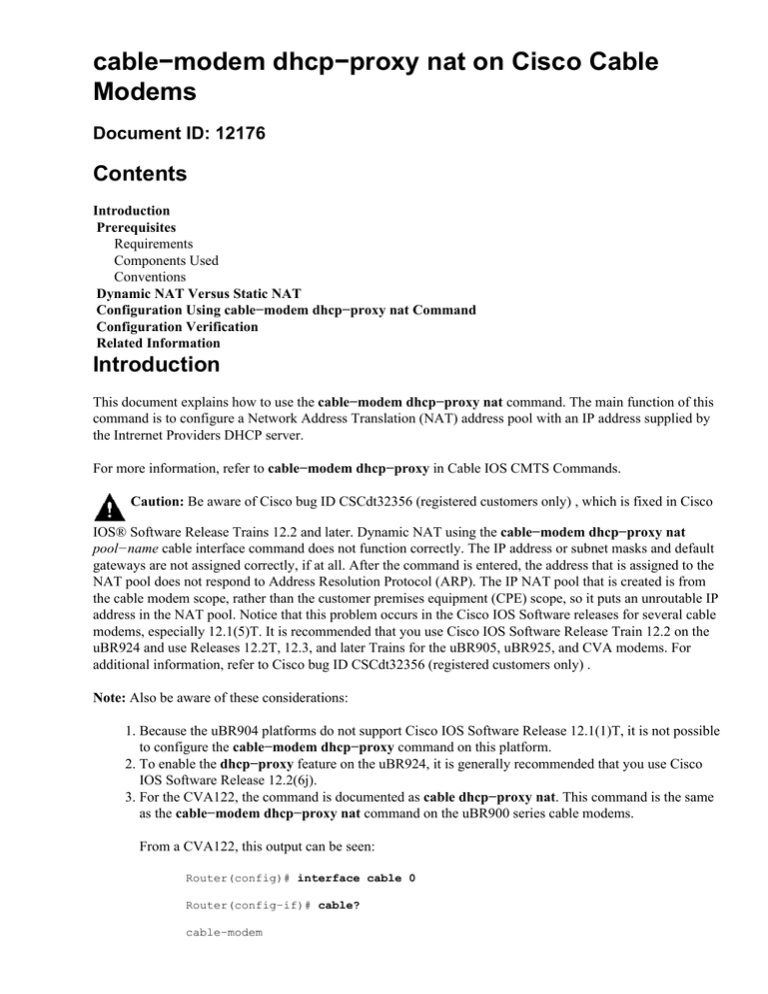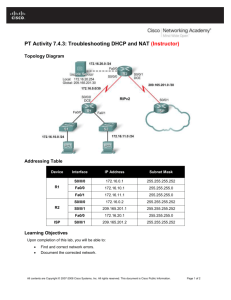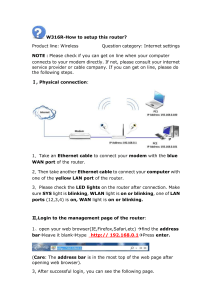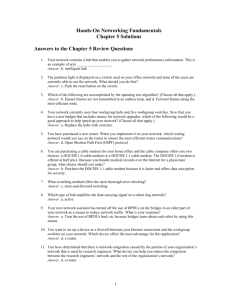
cable−modem dhcp−proxy nat on Cisco Cable
Modems
Document ID: 12176
Contents
Introduction
Prerequisites
Requirements
Components Used
Conventions
Dynamic NAT Versus Static NAT
Configuration Using cable−modem dhcp−proxy nat Command
Configuration Verification
Related Information
Introduction
This document explains how to use the cable−modem dhcp−proxy nat command. The main function of this
command is to configure a Network Address Translation (NAT) address pool with an IP address supplied by
the Intrernet Providers DHCP server.
For more information, refer to cable−modem dhcp−proxy in Cable IOS CMTS Commands.
Caution: Be aware of Cisco bug ID CSCdt32356 (registered customers only) , which is fixed in Cisco
IOS® Software Release Trains 12.2 and later. Dynamic NAT using the cable−modem dhcp−proxy nat
pool−name cable interface command does not function correctly. The IP address or subnet masks and default
gateways are not assigned correctly, if at all. After the command is entered, the address that is assigned to the
NAT pool does not respond to Address Resolution Protocol (ARP). The IP NAT pool that is created is from
the cable modem scope, rather than the customer premises equipment (CPE) scope, so it puts an unroutable IP
address in the NAT pool. Notice that this problem occurs in the Cisco IOS Software releases for several cable
modems, especially 12.1(5)T. It is recommended that you use Cisco IOS Software Release Train 12.2 on the
uBR924 and use Releases 12.2T, 12.3, and later Trains for the uBR905, uBR925, and CVA modems. For
additional information, refer to Cisco bug ID CSCdt32356 (registered customers only) .
Note: Also be aware of these considerations:
1. Because the uBR904 platforms do not support Cisco IOS Software Release 12.1(1)T, it is not possible
to configure the cable−modem dhcp−proxy command on this platform.
2. To enable the dhcp−proxy feature on the uBR924, it is generally recommended that you use Cisco
IOS Software Release 12.2(6j).
3. For the CVA122, the command is documented as cable dhcp−proxy nat. This command is the same
as the cable−modem dhcp−proxy nat command on the uBR900 series cable modems.
From a CVA122, this output can be seen:
Router(config)# interface cable 0
Router(config−if)# cable?
cable−modem
Prerequisites
Requirements
Readers of this document should have knowledge of these topics:
• Basic understanding of Network Address Translation and why it is used
• Data−over−Cable Service Interface Specifications (DOCSIS) 1.0 protocol
• The Cisco IOS Software command line interface
Components Used
This table shows the Cisco IOS Software releases that support this command for each Cisco cable modem
platform:
Release that introduced the cable−modem
dhcp−proxy command
12.1(1)T
12.1(3)XL
12.2(2)XA
12.1(5)XU1
Platform
uBR924
uBR905
uBR925
CVA122
The information in this document was created from the devices in a specific lab environment. All of the
devices used in this document started with a cleared (default) configuration. If your network is live, make sure
that you understand the potential impact of any command.
Conventions
Refer to Cisco Technical Tips Conventions for more information on document conventions.
Dynamic NAT Versus Static NAT
With dynamic NAT, translations do not exist in the NAT translation table until the router receives traffic that
requires translation. Dynamic translations have a time−out period, after which they are purged from the
translation table. With static NAT, however, translations exist in the NAT translation table as soon as you
configure a static NAT command, and they remain in the translation table until you delete the static NAT
command or commands.
The easiest way to determine that you have dynamic NAT configured in your cable modem is by searching for
this command in the configuration of the cable modem:
ip nat inside source list 100 interface cable−modem0 overload
By pointing the NAT source to an access list, you are dynamically building the NAT translation table. The
cable−modem dhcp−proxy nat command uses this dynamic NAT feature.
Configuration Using cable−modem dhcp−proxy nat
Command
When using the cable−modem dhcp−proxy nat command, the address used for the NAT pool is
automatically allocated from the cable operators DHCP server.
When using this option, include these NAT configuration commands:
• ip nat inside interfaceUse to configure the Ethernet interface as the inside interface.
• ip nat outside interfaceUse to configure the cable interface as the outside interface.
• overloadSpecify this option with the IP NAT global configuration command because the NAT pool
created by the cable−modem dhcp−proxy nat command contains only one IP address.
After configuring the router with the cable−modem dhcp−proxy nat command, reboot the router. During the
DOCSIS provisioning process, the router sends a DHCP client request to obtain an IP address for the cable
interface. The router then sends a proxy DHCP request to the DHCP server using the MAC address of the
Ethernet interface. The DHCP server replies with a second IP address that the router assigns to a dynamically
configured Loopback interface that is pointing to a dynamically configured NAT pool of only one address.
See the configuration output in this document for the information that is automatically added to the
configuration after DHCP is processed.
To configure NAT so that it creates the pool dynamically, issue these commands on your router. Remember
that, in order to configure NAT, your router must be in routing mode.
Router# config t
Enter configuration commands, one per line.
End with CNTL/Z.
Router(config)# interface ethernet 0
Router(config−if)# ip address 192.168.1.1 255.255.255.0
!−−− Assign an IP address to interface Ethernet 0.
Router(config−if)# no bridge−group 59
!−−− Remove bridging so that you can configure for routing.
Router(config−if)# no bridge−group 59 spanning
!−−− Remove bridging spanning.
Router(config−if)# ip nat inside
!−−− Enable NAT inside for the Ethernet interface.
Router(config−if)# exit
Router(config)#
Router(config)# interface cable 0
Router(config−if)# no bridge−group 59
!−−− Remove bridging so that you can configure for routing.
Router(config−if)# no bridge−group 59 spanning
!−−− Remove bridging spanning.
Router(config−if)# no cable compliant bridge
!−−− Remove bridging so that you can configure for routing.
Router(config−if)# ip nat outside
!−−− Enable NAT outside for the cable interface.
Router(config−if)# cable−modem dhcp−proxy nat TEST_POOL
!−−− Define dhcp−proxy nat for the TEST_POOL pool.
Router(config−if)# exit
Router(config)#
Router(config)# ip routing
!−−− Enable routing.
Router(config)# ip nat inside source list 1 pool TEST_POOL overload
!−−− Configure dynamic NAT.
Router(config)# access−list 1 permit 192.168.1.0 0.0.0.255
!−−− Define interesting traffic for NAT.
The configuration looks like this:
router# show run
Building configuration...
Current configuration : 953 bytes
!
version 12.2
no service single−slot−reload−enable
no service pad
service timestamps debug uptime
service timestamps log uptime
no service password−encryption
!
hostname router
!
logging rate−limit console 10 except errors
!
ip subnet−zero
no ip finger
!
ip audit notify log
ip audit PO max−events 100
no ip dhcp−client network−discovery
!
interface Ethernet0
ip address 192.168.1.1 255.255.255.0
ip nat inside
no ip mroute−cache
!
interface cable−modem0
ip nat outside
no ip mroute−cache
no cable−modem compliant bridge
cable−modem dhcp−proxy nat TEST_POOL
!
ip nat inside source list 1 pool TEST_POOL overload
ip classless
no ip http server
no ip http cable−monitor
!
access−list 1 permit 192.168.1.0 0.0.0.255
snmp−server packetsize 4096
snmp−server manager
!
voice−port 0
input gain −2
output attenuation 0
!
voice−port 1
input gain −2
output attenuation 0
!
!
line con 0
transport input none
line vty 0 4
login
!
end
router#
The bold commands are the ones you entered; the others are the defaults. Notice that the NAT pool has not
yet been created at this point. The cable modem needs to be reloaded, or the cable interface needs to be reset
by issuing the shut command followed by the no shut command.
router# reload
Proceed with reload? [confirm]
133.CABLEMODEM.CISCO: 00:06:16: %SYS−5−RELOAD: Reload requested
System Bootstrap, Version 12.0(6r)T3, RELEASE SOFTWARE (fc1)
Copyright (c) 1999 by Cisco Systems, Inc.
UBR924 platform with 16384 Kbytes of main memory
program load complete, entry point: 0x80010000, size: 0x398070
Self decompressing the image : #################################
################################################################
################################################################
################################################################
################################################################
################################################################
########################################################## [OK]
!−−− Output suppressed.
Press RETURN to get started!
Note: In the configuration output, information that is automatically added to the configuration after DHCP is
processed is noted with comments.
In this document, a uBR7114 and uBR924 are used as examples. The Cisco IOS Software releases installed
on them are 12.1(5)EC1 and 12.1(3a)T4, respectively. The next figure shows the connectivity and IP
addresses used.
Figure 1: Diagram used in the configuration using cable dhcp−proxy nat command
uBR924Configuration of the NAT address pool with an IP address supplied by
the Service Providers DHCP server
router# show run
Building configuration...
Current configuration : 1273 bytes
!
! Last configuration change at 13:12:52 − Tue Feb 29 2000
!
version 12.2
no service single−slot−reload−enable
no service pad
service timestamps debug uptime
service timestamps log uptime
no service password−encryption
!
hostname router
!
logging rate−limit console 10 except errors
!
clock timezone − −8
ip subnet−zero
no ip finger
!
ip audit notify log
ip audit PO max−events 100
no ip dhcp−client network−discovery
!
!
interface Loopback0
ip address 111.111.111.8 255.255.255.255
!−−− Lookback interface added automatically by DHCP configuration.
!
interface Ethernet0
ip address 192.168.1.1 255.255.255.0
ip nat inside
no ip mroute−cache
!
interface cable−modem0
ip nat outside
no ip mroute−cache
no cable−modem compliant bridge
cable−modem dhcp−proxy nat TEST_POOL
cable−modem boot admin 2
cable−modem boot oper 5
cable−modem downstream saved channel 525000000 37 1
!
ip nat pool TEST_POOL 111.111.111.8 111.111.111.8 netmask 255.255.255.0
!−−− NAT pool added automatically by DHCP configuration.
ip nat inside source list 1 pool TEST_POOL overload
ip classless
no ip http server
no ip http cable−monitor
!
access−list 1 permit 192.168.1.0 0.0.0.255
snmp−server packetsize 4096
snmp−server manager
!
voice−port 0
input gain −2
output attenuation 0
!
voice−port 1
input gain −2
output attenuation 0
!
!
line con 0
transport input none
line vty 0 4
login
!
end
Configuration Verification
This section describes how to use show command output to verify the configuration of the cable modem.
Certain show commands are supported by the Output Interpreter Tool (registered customers only) , which
allows you to view an analysis of show command output.
Issue the show arp command to display the entries in the ARP table.
router# show arp
Protocol
Internet
Internet
Address
Age (min) Hardware Addr
111.111.111.111
56
0002.b9ff.8c1c
10.4.1.1
59
0002.b9ff.8c1c
Type
ARPA
ARPA
Interface
cable−modem0
cable−modem0
ARPA
ARPA
Ethernet0
Ethernet0
ARPA
cable−modem0
!−−− IP address of the interface cable 1/0
!−−− of the cable modem termination system (CMTS).
Internet
Internet
192.168.1.1
192.168.1.5
−
34
0030.1976.771a
00a0.243c.eff5
!−−− IP address of the PC behind the cable modem.
Internet
10.4.1.114
−
0030.1976.771b
The PC behind the cable modem has IP address 192.168.1.5 statically configured. It is very easy, however, to
make the cable modem a DHCP server which dynamically assigns an IP address to its LAN hosts; use this
configuration:
ip dhcp excluded−address 192.168.1.1
ip dhcp pool pool name
network 192.168.1.0 255.255.255.0
default−router 192.168.1.1
To test that NAT works, issue a ping command from the PC connected behind the cable modem to try to
reach the cable interface.
If you look at the NAT translation table, you can see successful translations.
router# show ip nat translations
Pro Inside global
icmp 111.111.111.8:512
Inside local
192.168.1.5:512
Outside local
10.4.1.114:512
Outside global
10.4.1.114:512
For more information, refer to cable−modem dhcp−proxy in Cable IOS CMTS Commands.
Related Information
• NAT (Network Address Translation) Support Pages
• Bridging and Routing Features for the Cisco uBR904 Cable Modem
• Cable CPE Commands
• Cisco CVA120 Series Cable Voice Adapter Features
• Technical Support − Cisco Systems
Contacts & Feedback | Help | Site Map
© 2014 − 2015 Cisco Systems, Inc. All rights reserved. Terms & Conditions | Privacy Statement | Cookie Policy | Trademarks of
Cisco Systems, Inc.
Updated: Nov 20, 2006
Document ID: 12176





